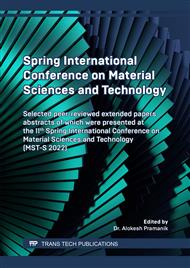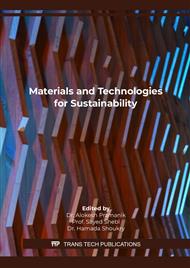[1]
H. Zhao, G. Baptiste, P. Dirk, et al. Parameter free quantitative analysis of atom probe data by correlation functions: Application to the precipitation in Al-Zn-Mg-Cu, Scr. Mater. 154 (2018) 106-110.
DOI: 10.1016/j.scriptamat.2018.05.024
Google Scholar
[2]
A. Heinz, A. Haszler, C. Keidel, et al. Recent development in aluminium alloys for aerospace applications, Mater. Sci. Eng. A. 280 (2000) 102-107.
DOI: 10.1016/s0921-5093(99)00674-7
Google Scholar
[3]
Y. Zhang, B. Milkereit, O. Kessler, et al. Development of continuous cooling precipitation diagrams for aluminium alloys AA7150 and AA7020, J. Alloys Compd. 584 (2014) 581-589.
DOI: 10.1016/j.jallcom.2013.09.014
Google Scholar
[4]
J. C. Lin, H. L. Liao, W. D. Jehng, et al. Effect of heat treatments on the tensile strength and SCC-resistance of AA7050 in an alkaline saline solution, Corros. Sci. 48 (2006) 3139-3156.
DOI: 10.1016/j.corsci.2005.11.009
Google Scholar
[5]
J. A. Liu, C. L. Sheng. Production Technology of aluminum alloy forging and application of forging, Nonferrous Metals Processing. 41 (2012) 1-5.
Google Scholar
[6]
G. Shi, Y. Zhang, H. Liu, et al. Constructing processing maps for hot deformation and microstructural evolution of Al–Zn–Mg–Cu alloys, Mater. Res. Express. 6 (2019) 096566.
DOI: 10.1088/2053-1591/ab2fb4
Google Scholar
[7]
D. Feng, X. M. Zhang, S. D. Liu, et al. Rate controlling mechanisms in hot deformation of 7A55 aluminum alloy, T. Nonferr. Metal. Soc. 24 (2014) 28-35.
DOI: 10.1016/s1003-6326(14)63024-7
Google Scholar
[8]
F. Jiang, H. Zhang, S. Weng, et al. Characterization of dynamic microstructural evolution of AA7150 aluminum alloy at high strain rate during hot deformation, Trans. Nonferrous Met. Soc. China. 26 (2016) 51-62.
DOI: 10.1016/s1003-6326(16)64087-6
Google Scholar
[9]
Q. Yang, Z. Deng, Z. Zhang, et al, Effects of strain rate on flow stress behavior and dynamic recrystallization mechanism of Al-Zn-Mg-Cu aluminum alloy during hot deformation, Mater. Sci. Eng. A. 662 (2016) 204-213.
DOI: 10.1016/j.msea.2016.03.027
Google Scholar
[10]
C. Xu, H. He, Z. Xue, et al, A detailed investigation on the grain structure evolution of AA7005 aluminum alloy during hot deformation, Mater. Charact. 171 (2021) 110801.
DOI: 10.1016/j.matchar.2020.110801
Google Scholar
[11]
E. Hornbogen, E.A. Starke Jr., Theory assisted design of high strength low alloy aluminum, Acta Metall. Mater. 41 (1993) 1–16.
DOI: 10.1016/0956-7151(93)90334-o
Google Scholar
[12]
M. Dixit, R. S. Mishra, K. K. Sankaran, Structure–property correlations in Al 7050 and Al 7055 high-strength aluminum alloys, Mater. Sci. Eng. A. 478 (2007) 163-172.
DOI: 10.1016/j.msea.2007.05.116
Google Scholar
[13]
J. Pokluda, Dislocation-based model of plasticity and rough-ness-induced crack closure, Int. J. Fatigue. 46 (2013) 35.
DOI: 10.1016/j.ijfatigue.2011.11.016
Google Scholar
[14]
A. Turnbull, E. R. D. L. Rios, The effect of grain size on fatigue crack growth in an aluminium magnesium alloy, Fatigue Fract. Eng. Mater. Struct. 18 (2010) 1355.
DOI: 10.1016/s0142-1123(97)83282-3
Google Scholar
[15]
L. Tan, X. Y. Zhang, T. Xia, et al, Fracture morphology and crack mechanism in pure polycrystalline magnesium under tension–compression fatigue testing, Rare Met. 39 (2020) 162.
DOI: 10.1007/s12598-018-01200-3
Google Scholar



